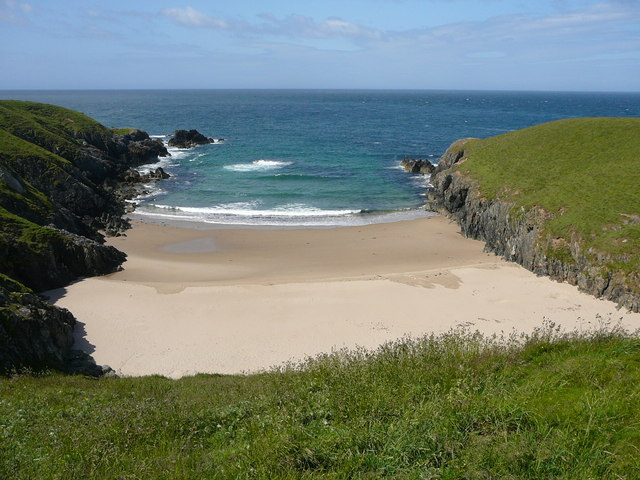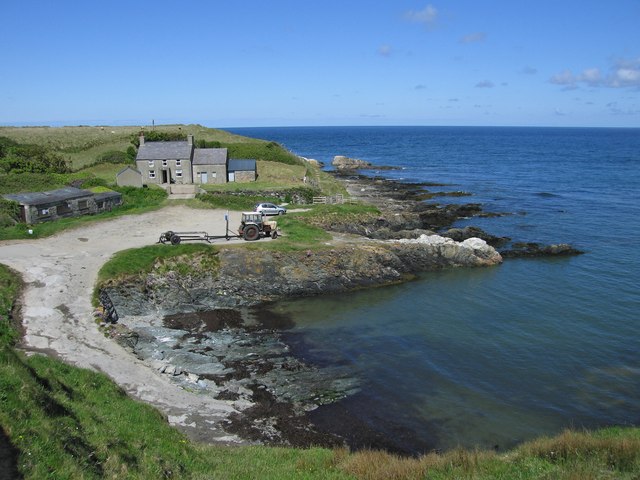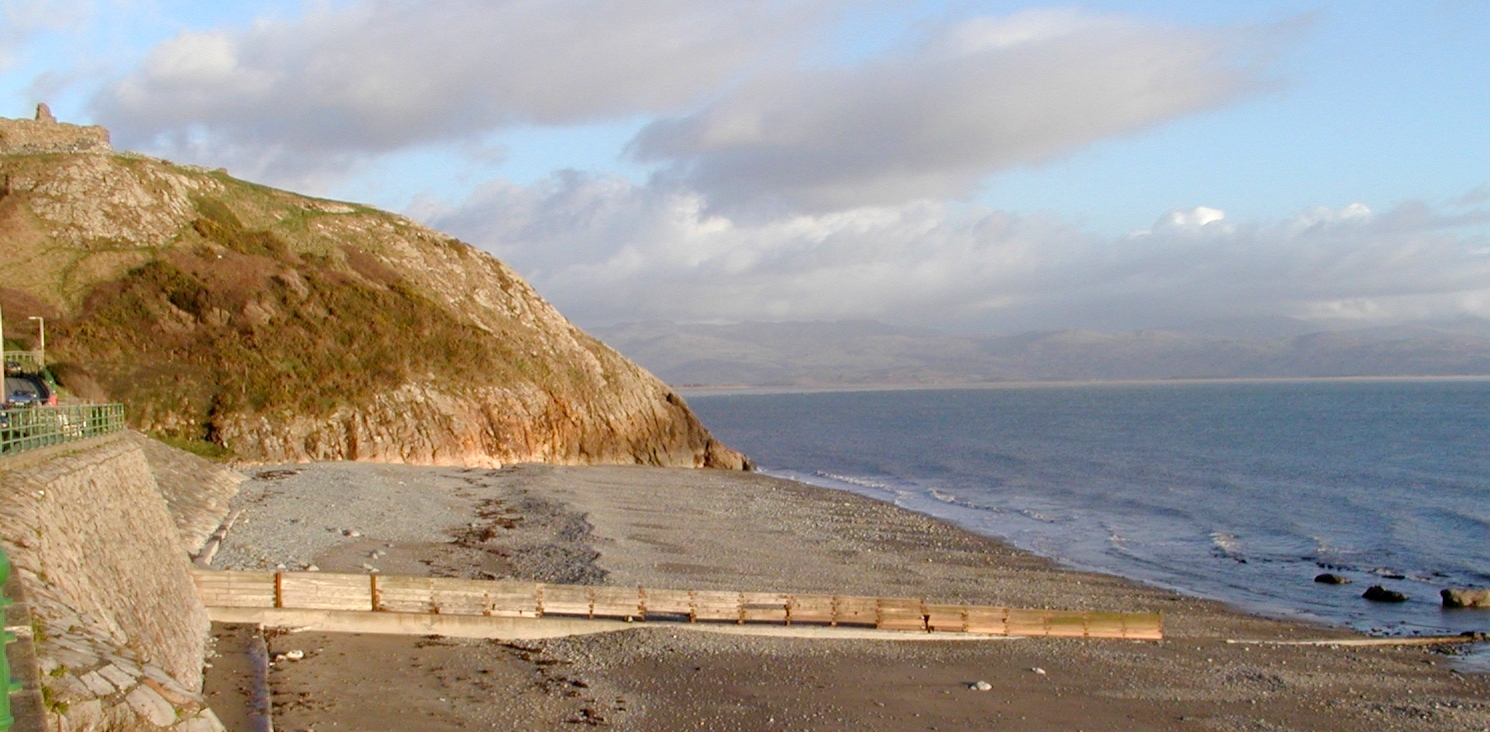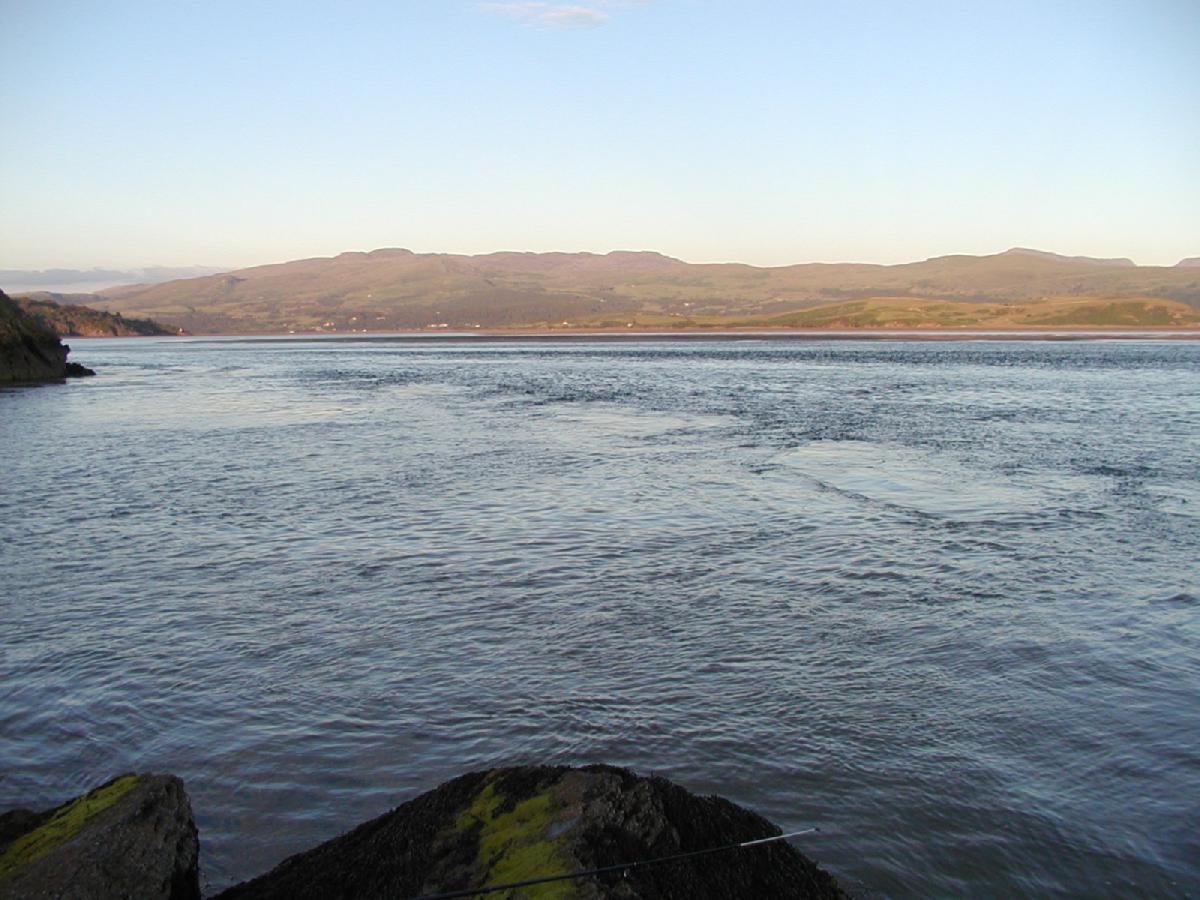
Llyn Peninsula Overview
Popular Marks
Last Updated November 2022
Popular Marks
Last Updated November 2022
The Llyn Peninsula extends for around 30 miles in a west south westerly direction. From Dinas Dinlle in the north east to Aberdaron at it's south western point and back east to Porthmadog at its south eastern end. The coastline is approximately 105km or 65 miles in length. For most of it's lenght the peninsula is only 12km or 8miles wide.
The coastline is offers a mix of sandy beaches and some serious rock marks. With the peninsula being so narrow the only major river estuary is at the south eastern point where the River Glaslyn is joined by the River Dwyryd appoximately 1 mile from Porthmadog close to Both-y-Gest.
There are smaller estuaries at Abersoch, Pwllheli and 1m west of Criccieth.
The number of species of fish is quite extensive and depending upon the season you'll have a chance of catching any of the fish listed below from a mark somewhere on the Llyn.
Bass, Smooth Hound, Plaice, Flounder, Dab, Turbot, Mullet, Mackerel, Tope, Wrasse, Ray's (Spotted, Thornback Blonde), Huss, Dogfish, Bream, Gurnard, Conger, Whiting, Codling, Coalfish and Silver Eels.
The Llyn Peninsula
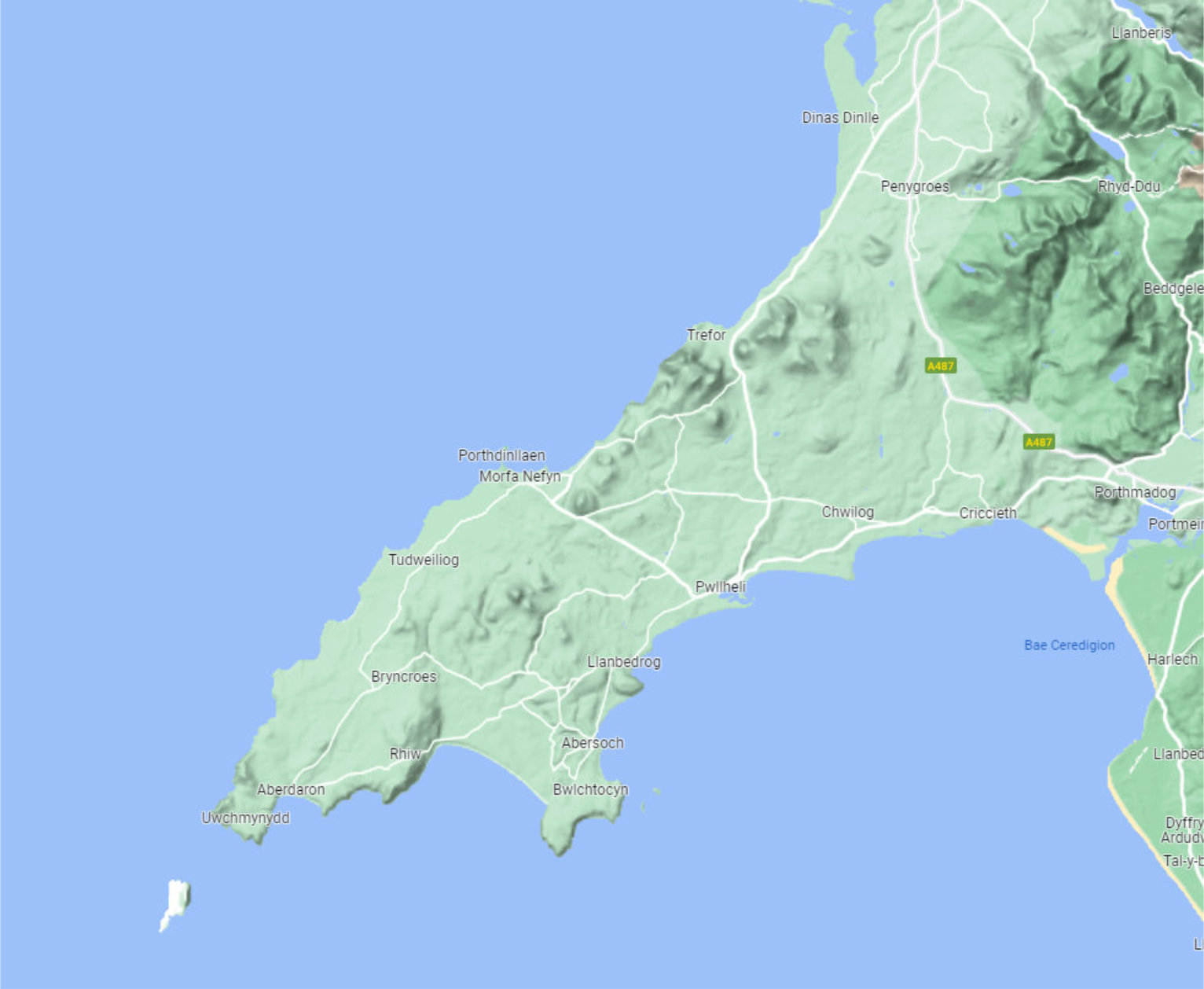

For the purpose of the guide the peninusla can be broken down into 3 quite distict sections.
- The North Coast covering the area from Dinas Dinlle in the north eastern part as far south west as Morfa Nefyn.
- The western tip from Morfa Nefyn around to Abersoch
- The south coast from Abersoch to Porthmadog.
Tackle and Bait shops are few and far between on the peninsula. Make the most of these 3 at Criicieth, Pwllheli and Caernarfon.
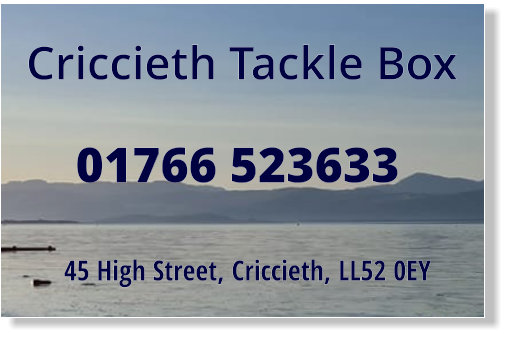

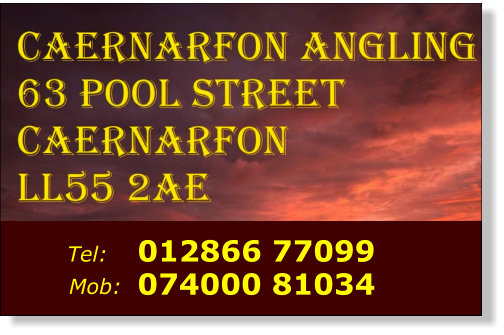
North Coast of Llyn Peninsula
Caernarfon Victoria Dock & Landerne Pier
Easy access fishing marks. Probably not a first choice mark but offers a good option when conditions on the open coast are making other venues difficult or impossible to fish. Avoid spring tides. This mark can be fished at all states of the tide
In summer expect dogfish, small pollack, plaice, bass, smooth hounds and small wrasse are the mainstay of catches. It's also a great spot for mini-species.
Autum brings codling, whiting as well as huss.

Directions from Y Felinheli A487
Easy access fishing marks. Probably not a first choice mark but offers a good option when conditions on the open coast are making other venues difficult or impossible to fish. Avoid spring tides. This mark can be fished at all states of the tide
In summer expect dogfish, small pollack, plaice, bass, smooth hounds and small wrasse are the mainstay of catches. It's also a great spot for mini-species.
Autum brings codling, whiting as well as huss.

Directions from Y Felinheli A487
Dinas Dinlle
Dinas is possibly the most famous Llyn mark. It's reputation was built back in the 1950s and early 1960s around the quality of the tope fishing in provided. While tope are still caught they are quite rare now in the 21st century.
Bass, rays, huss, smooth hounds along with the autum and winter visitors, whiting, coalfish and codling are all the ususal suspects. It's a shallow beach backed by a single bank. Fish it over the HW period after dark for best results.
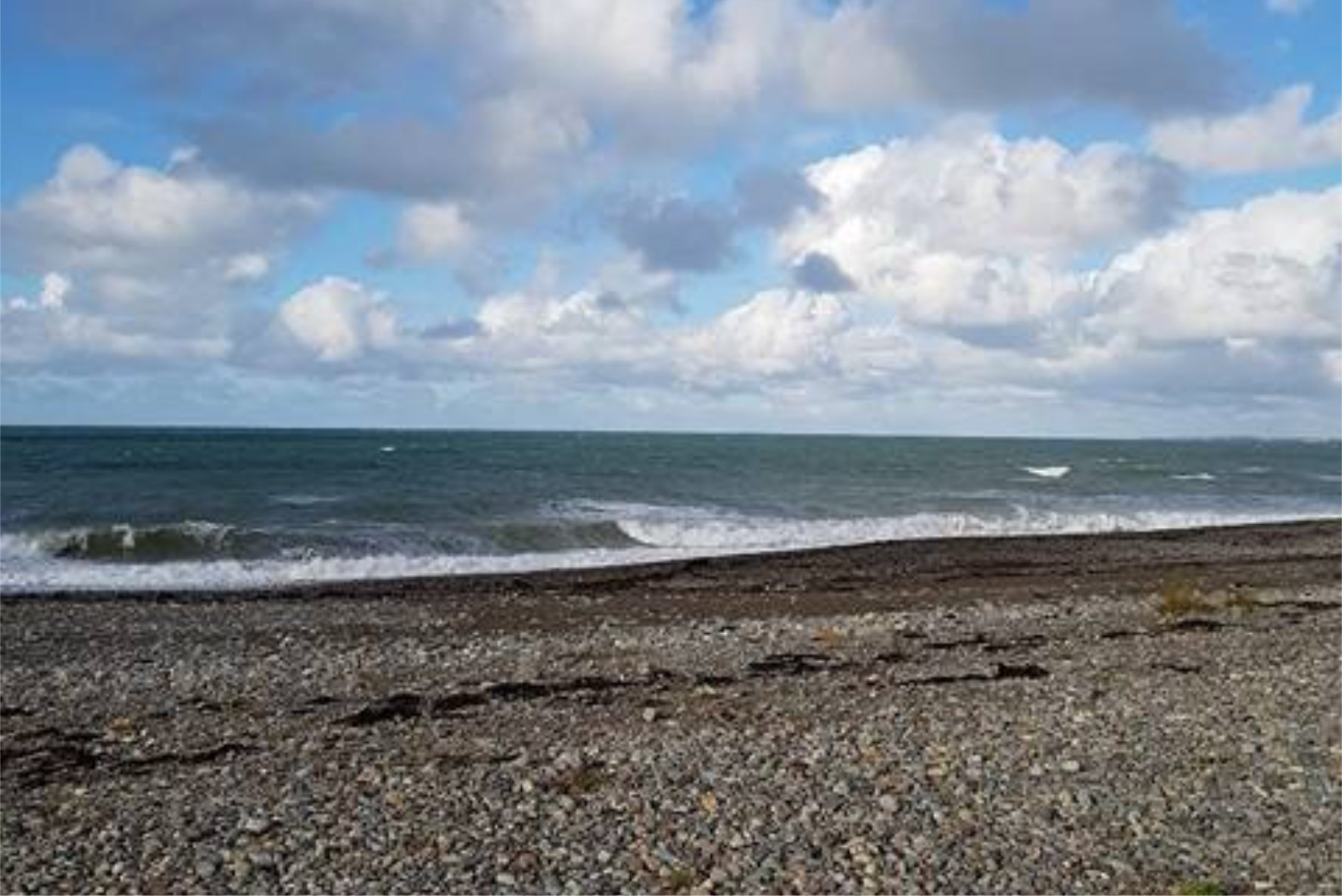
Directions from Caernarfon
Dinas is possibly the most famous Llyn mark. It's reputation was built back in the 1950s and early 1960s around the quality of the tope fishing in provided. While tope are still caught they are quite rare now in the 21st century.
Bass, rays, huss, smooth hounds along with the autum and winter visitors, whiting, coalfish and codling are all the ususal suspects. It's a shallow beach backed by a single bank. Fish it over the HW period after dark for best results.

Directions from Caernarfon
Trefor
Sadly the the wooden pier has been demolised and is no longer there. Today fishing is from the wall into the area where the pier was. It's a comfortable spot which can reward you with quality huss from late March right through until Christmas. From September until early spring whiting and coalfish can be expected in good numbers.
Sadly the the wooden pier has been demolised and is no longer there. Today fishing is from the wall into the area where the pier was. It's a comfortable spot which can reward you with quality huss from late March right through until Christmas. From September until early spring whiting and coalfish can be expected in good numbers.
Drone clip from Evans' SkyTech Videos
Wern
The Wern is the area at the eastern end of Nefyn Beach. It can be reached by taking the B4417 road from Nefyn heading towards Pistyll. After 1km (2/3 mile) you reach Wern Caravan Site. There is a small area just big enough for one vehicle to park. Park there. On the opposite side of the road is a kissing gate and public footpath. Follow this to the beach.
A walk of around 750m to your right takes you to the headland where the Old Pistyll Dock is. Fishing off the rocks or the old dock will involve a bit of a scamble with a rather tricky step from the rocks to the old dock.
The wide range of regular Llyn species are available with the addition of rays, thornback, spotted and occasional blondes, as well as smooth hounds over warmer summer months. The beach itself produces plenty of coalfish from October through to early spring.
Well worth fishing but parking is tricky.
The Wern is the area at the eastern end of Nefyn Beach. It can be reached by taking the B4417 road from Nefyn heading towards Pistyll. After 1km (2/3 mile) you reach Wern Caravan Site. There is a small area just big enough for one vehicle to park. Park there. On the opposite side of the road is a kissing gate and public footpath. Follow this to the beach.
A walk of around 750m to your right takes you to the headland where the Old Pistyll Dock is. Fishing off the rocks or the old dock will involve a bit of a scamble with a rather tricky step from the rocks to the old dock.
The wide range of regular Llyn species are available with the addition of rays, thornback, spotted and occasional blondes, as well as smooth hounds over warmer summer months. The beach itself produces plenty of coalfish from October through to early spring.
Well worth fishing but parking is tricky.
Nefyn
A shallow, flat and sandy beach which is best fished a few hours down to LW and for around 3hrs of the flood. Standard clean ground beach gear is all that's needed.
Bass, dab, dogfish, plaice and smooth hounds are the mainstays of catches over the warmer months with whiting, coalfish and codling over autumn and winter.
Thornback ray, spotted ray, small eyed ray along with turbot also feature at times.
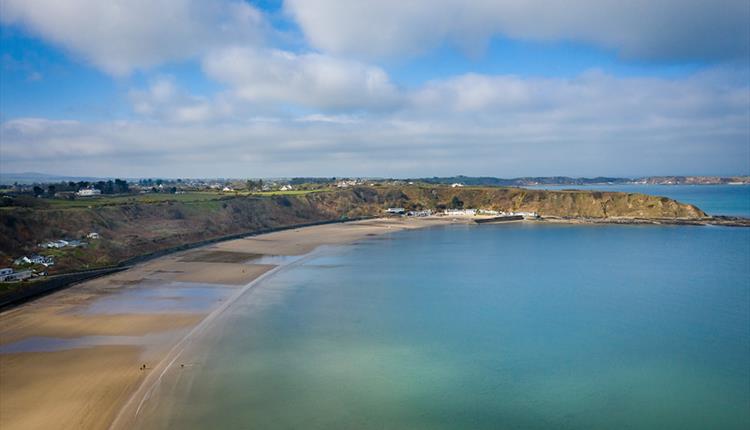
A shallow, flat and sandy beach which is best fished a few hours down to LW and for around 3hrs of the flood. Standard clean ground beach gear is all that's needed.
Bass, dab, dogfish, plaice and smooth hounds are the mainstays of catches over the warmer months with whiting, coalfish and codling over autumn and winter.
Thornback ray, spotted ray, small eyed ray along with turbot also feature at times.

Nefyn Beach
Western Tip of Llyn Peninsula
Porth Iago
A small shelted beach flanked by rocky headlands left and right. You can drive right up to the headland a park. There's a charge for access to the land which is paid via a machine at the farm either £1 coins or by card.
A short walk around the headlands offers some fantatic fishing from the rocks. wrasse and pollack are plentiful and great fun on lighter gear. Float fishing and lure fishing heaven!
Bottom fishing the beach is clean ground with doggies, huss and bass your main target species. From the rocks bottom fishing gives a change of conger, huss and tope to large fish baits.
.
Directions from Nefyn
A small shelted beach flanked by rocky headlands left and right. You can drive right up to the headland a park. There's a charge for access to the land which is paid via a machine at the farm either £1 coins or by card.
A short walk around the headlands offers some fantatic fishing from the rocks. wrasse and pollack are plentiful and great fun on lighter gear. Float fishing and lure fishing heaven!
Bottom fishing the beach is clean ground with doggies, huss and bass your main target species. From the rocks bottom fishing gives a change of conger, huss and tope to large fish baits.
.
Directions from Nefyn
Porth Colmon
A once upon a time favorite area for me lure and float fishing exploits. You need to be reasonably fit and agile to get the most out of the opportunities here. The area hold some big wrasse which lie in wait foir a feed right hard againt the rock faces right under your feet.
Pollack and mackerel will keep you interested with lures and there's always the change of a nice bass.
Parking is limited at Port Colmon.
Directions from Nefyn
A once upon a time favorite area for me lure and float fishing exploits. You need to be reasonably fit and agile to get the most out of the opportunities here. The area hold some big wrasse which lie in wait foir a feed right hard againt the rock faces right under your feet.
Pollack and mackerel will keep you interested with lures and there's always the change of a nice bass.
Parking is limited at Port Colmon.
Directions from Nefyn
Uwchmynnynd
Not a mark for anyone other than the seriuosly fit and an experienced 'rock hopper'. The chance to drop a bait into some very deep water and a very strong tidal flow are what set this mark apart in a league of its own. If it swims in UK waters there's a great chance you catch it from here.
Big conger, huss, pollack, wrasse and tope are are the headline species. The ground as you'd imagine is pretty rough and the climb down to reach the few spots to fish from is a challenge. The one mark is reached down a very step path which is affectionately known as 'Cardic Hill'. Steer well clear of the rocks when it's wet!
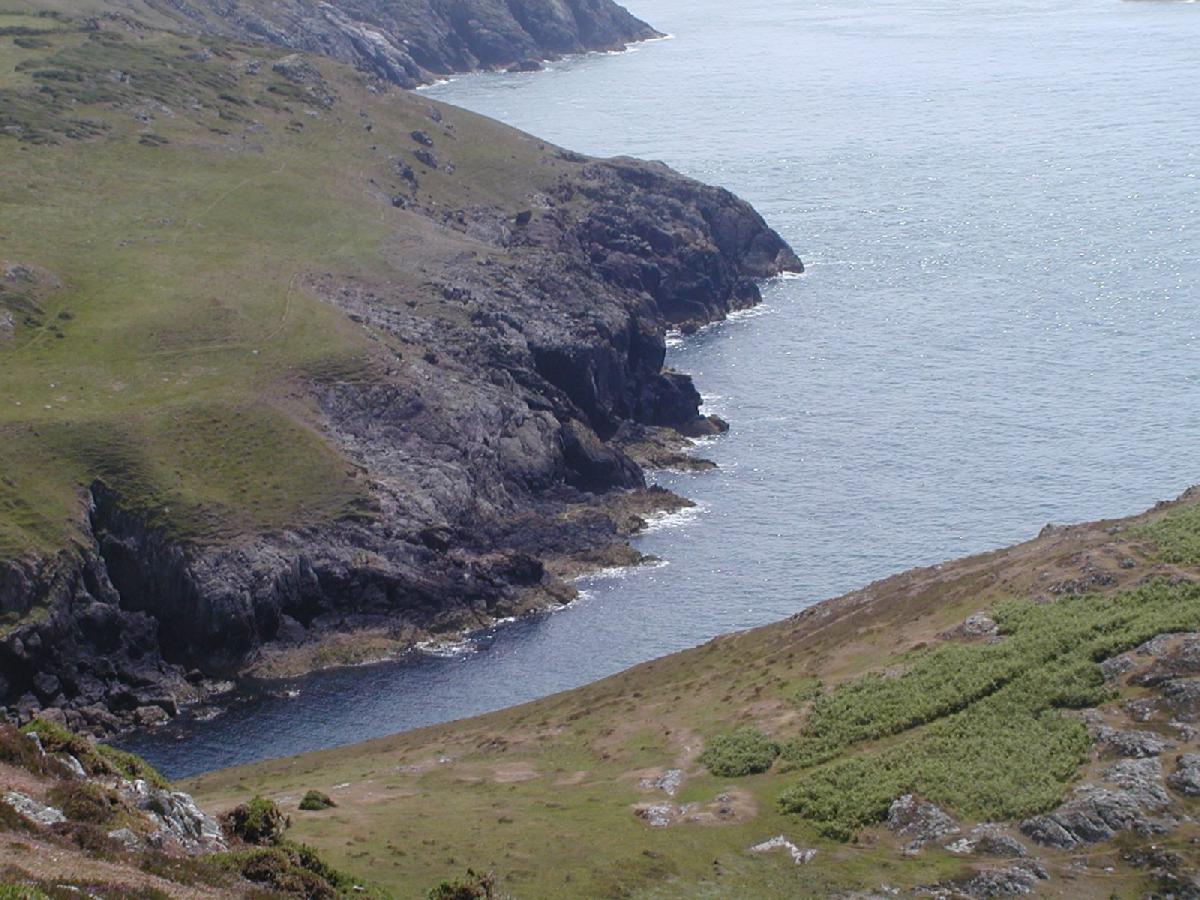
Directions from Aberdaron
Not a mark for anyone other than the seriuosly fit and an experienced 'rock hopper'. The chance to drop a bait into some very deep water and a very strong tidal flow are what set this mark apart in a league of its own. If it swims in UK waters there's a great chance you catch it from here.
Big conger, huss, pollack, wrasse and tope are are the headline species. The ground as you'd imagine is pretty rough and the climb down to reach the few spots to fish from is a challenge. The one mark is reached down a very step path which is affectionately known as 'Cardic Hill'. Steer well clear of the rocks when it's wet!

The view from the top of Cardiac Hill give a flavour of what the terrain is like.
Directions from Aberdaron
Porthor (Whistling Sands
ALying on the north coast just 5.5km (3.5m) from the tip of the peninsula Whistling Sands offers some protection from the prevailing south westerly winds which can make fishing difficult at times.
In addition to it's location the beach is completley surronded by steep cliffs which offer protection to all but winds from the north west.
The beach is reached via a private track and the land is owned by the National Trust. You park on the cliff tops above the beach.
You can expect bass, dogfish and flatties from the main beach with pollack and wrasse from the rocks. Autumn and winter see an influx of coalfish.
This is a very busy spot in summer!
ALying on the north coast just 5.5km (3.5m) from the tip of the peninsula Whistling Sands offers some protection from the prevailing south westerly winds which can make fishing difficult at times.
In addition to it's location the beach is completley surronded by steep cliffs which offer protection to all but winds from the north west.
The beach is reached via a private track and the land is owned by the National Trust. You park on the cliff tops above the beach.
You can expect bass, dogfish and flatties from the main beach with pollack and wrasse from the rocks. Autumn and winter see an influx of coalfish.
This is a very busy spot in summer!
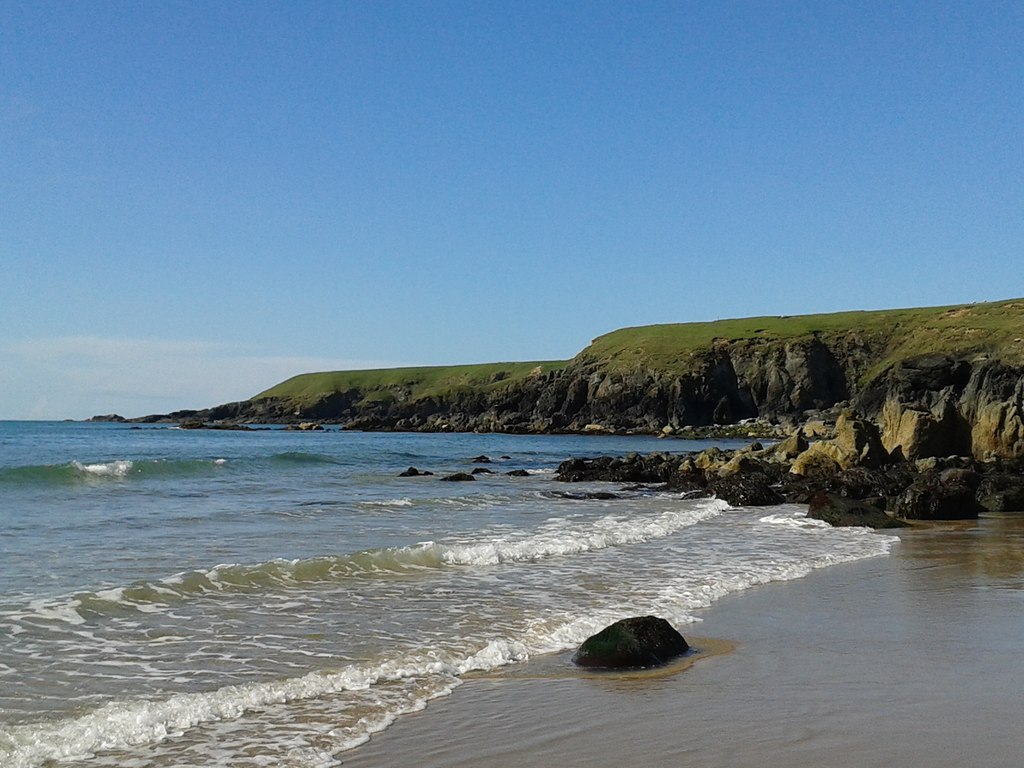
Port Oer - Whistling Sands
© Copyright I Love Colour and licensed for reuse under this Creative Commons Licence.
Hells Mouth / Porth Neigwl
A once very popular mark with a reputation for the quality of it's bass fishing. It's a true storm beachy facing west. From Rhiw at it's northern end to Cilan Head at the southern end it' just over 5.5km (3.5 miles) long. The top of the beach is shingle and small boulders backed by clay cliffs. On large spring tides the sea will reach the bottom of the cliffs so make sure you have a good exit strategy! If there's a strong westerly blow the sea can reach the foot of the cliffs even on smaller neap tides!
Other species caught include rays, bull huss, doggies, pollack, small turbot and over the colder months whiting and coalfish.
WARNING - Hells Mouth has in recent years become a Mecca for the surfing brigade. If you go there and find it packed with surfers have a plan B ready!
See how visit Wales describe Hells Mouth
A once very popular mark with a reputation for the quality of it's bass fishing. It's a true storm beachy facing west. From Rhiw at it's northern end to Cilan Head at the southern end it' just over 5.5km (3.5 miles) long. The top of the beach is shingle and small boulders backed by clay cliffs. On large spring tides the sea will reach the bottom of the cliffs so make sure you have a good exit strategy! If there's a strong westerly blow the sea can reach the foot of the cliffs even on smaller neap tides!
Other species caught include rays, bull huss, doggies, pollack, small turbot and over the colder months whiting and coalfish.
WARNING - Hells Mouth has in recent years become a Mecca for the surfing brigade. If you go there and find it packed with surfers have a plan B ready!
See how visit Wales describe Hells Mouth
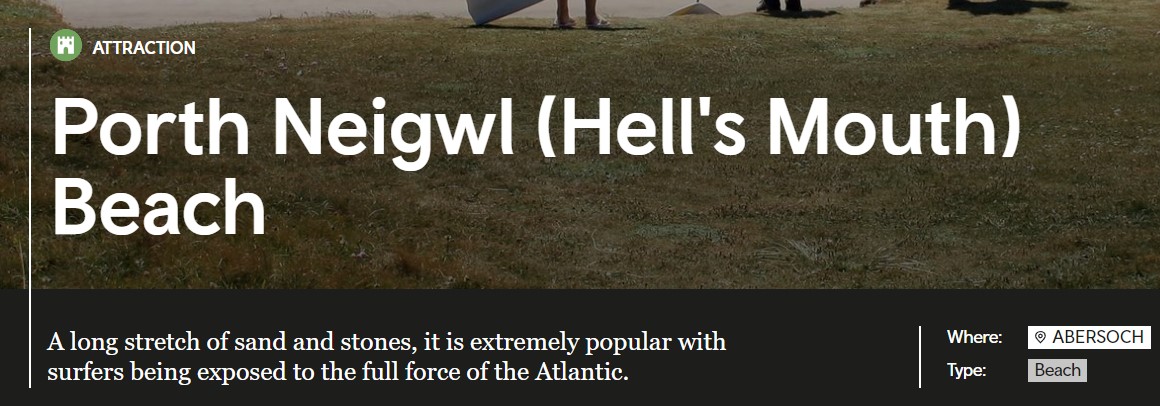
Aberdaron
A storm beach right at the tip of the peninsula which gives the chance of bass all year round. Most fish will be in the 1lb to 3lb range but in autumn there's a chance of larger fish. It's a popular beach with holiday makers in the summer so fish early morning or late evening to avoid the crowds.
It can fished over LW and all the way up to HW.
In the autumn and winter fishing in darkness will ensure you get plenty of whiting and dogfish.
It's not a mark you'd trek the full lenght of the peninsula to fish as your first choice mark but it offers comfortable easy access to the sea which is a bonus this far down the peninsula.
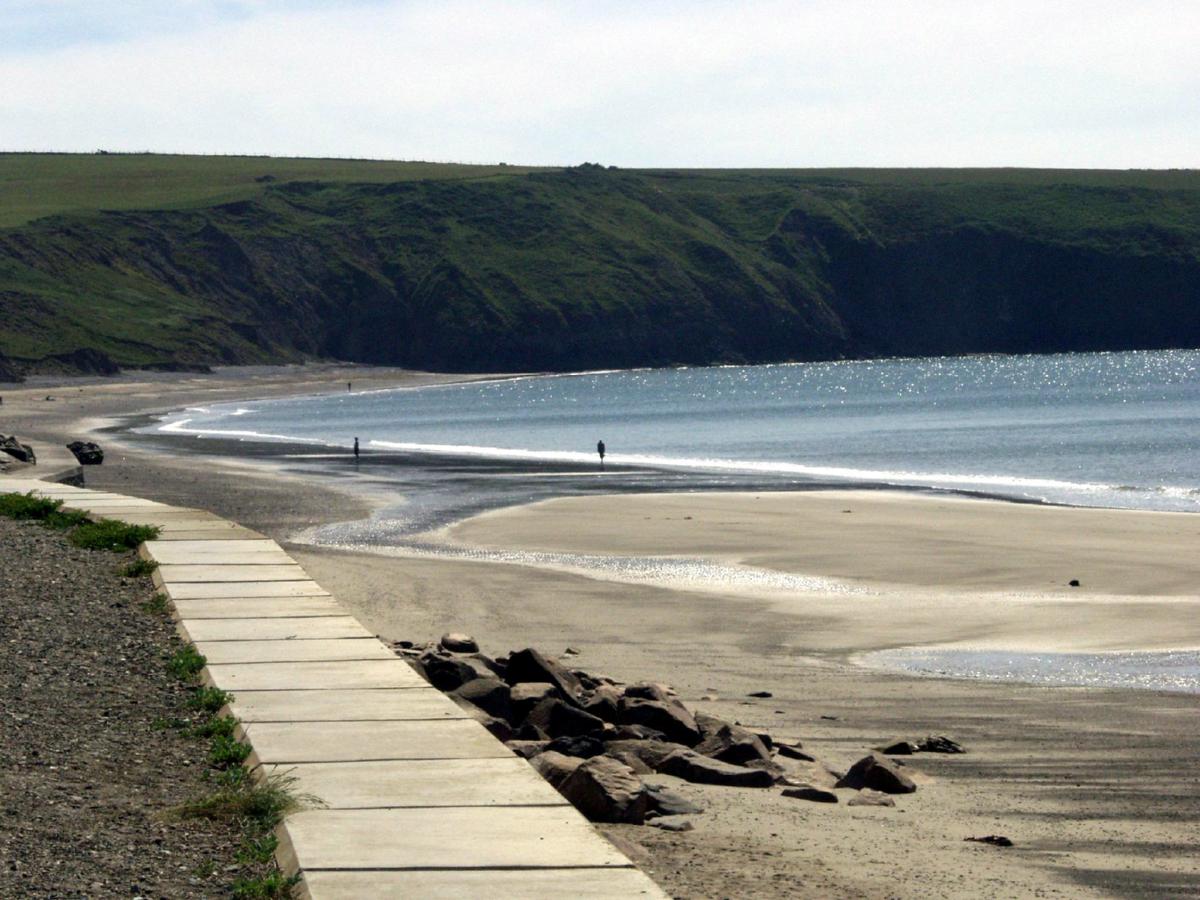
A storm beach right at the tip of the peninsula which gives the chance of bass all year round. Most fish will be in the 1lb to 3lb range but in autumn there's a chance of larger fish. It's a popular beach with holiday makers in the summer so fish early morning or late evening to avoid the crowds.
It can fished over LW and all the way up to HW.
In the autumn and winter fishing in darkness will ensure you get plenty of whiting and dogfish.
It's not a mark you'd trek the full lenght of the peninsula to fish as your first choice mark but it offers comfortable easy access to the sea which is a bonus this far down the peninsula.

Aberdaron Beach. Clean ground and easy access!
Cilian Uchaf (Cilan Head)
A mark with a great reputation for the quality of the fishing it offers. Big tope, pollack, and wrasse but you'll have to put in a far bit of effort to reap the rewards!
It really isn't a mark for anyone who's not reasonablily fit and agile as reaching the rock platforms isn't hard and it's a longish trek just to them. Then you'll be faced with a tricky bit of scambling down to fish.
Personally I avoid the place. I went to check it out about 40 years ago when in my 20s and even then the terrain and effort saw me shy away and cross it off my bucket list.
A mark with a great reputation for the quality of the fishing it offers. Big tope, pollack, and wrasse but you'll have to put in a far bit of effort to reap the rewards!
It really isn't a mark for anyone who's not reasonablily fit and agile as reaching the rock platforms isn't hard and it's a longish trek just to them. Then you'll be faced with a tricky bit of scambling down to fish.
Personally I avoid the place. I went to check it out about 40 years ago when in my 20s and even then the terrain and effort saw me shy away and cross it off my bucket list.
The National Trust's take on Cilan Head . . .
Cilian Head
Rock climbing in Llŷn is serious business with the cliffs of Cilan Head having a particular aura in the climbing world.
This special place offers cutting-edge climbing at its purest for those with experience, skill and nerve. Many of its routes, such as ‘Vul-ture’ and ‘Path to Rome’, are regarded as some of the best of their type in Britain.
Cilian Head
Rock climbing in Llŷn is serious business with the cliffs of Cilan Head having a particular aura in the climbing world.
This special place offers cutting-edge climbing at its purest for those with experience, skill and nerve. Many of its routes, such as ‘Vul-ture’ and ‘Path to Rome’, are regarded as some of the best of their type in Britain.
South Coast of Llyn Peninsula
Pwllheli
The beach stretches from Gimblet Rock at it's eastern end westwards for almost 5km or 3 miles to Traeth Crugan at it's western end. Most of the fishing is concentrated between Gimblet Rock and the Golf Course. The water is slightly deepr close to Gimblet Rock. The list of species available is pretty extensive and includes sizeable tope.
For some reason smooth hounds are noticeable by their absce in this area. It can only be a matter of time before they start to be caught as in recent years their range has steadily been increasing and they are being caught from places with no previous history of them.
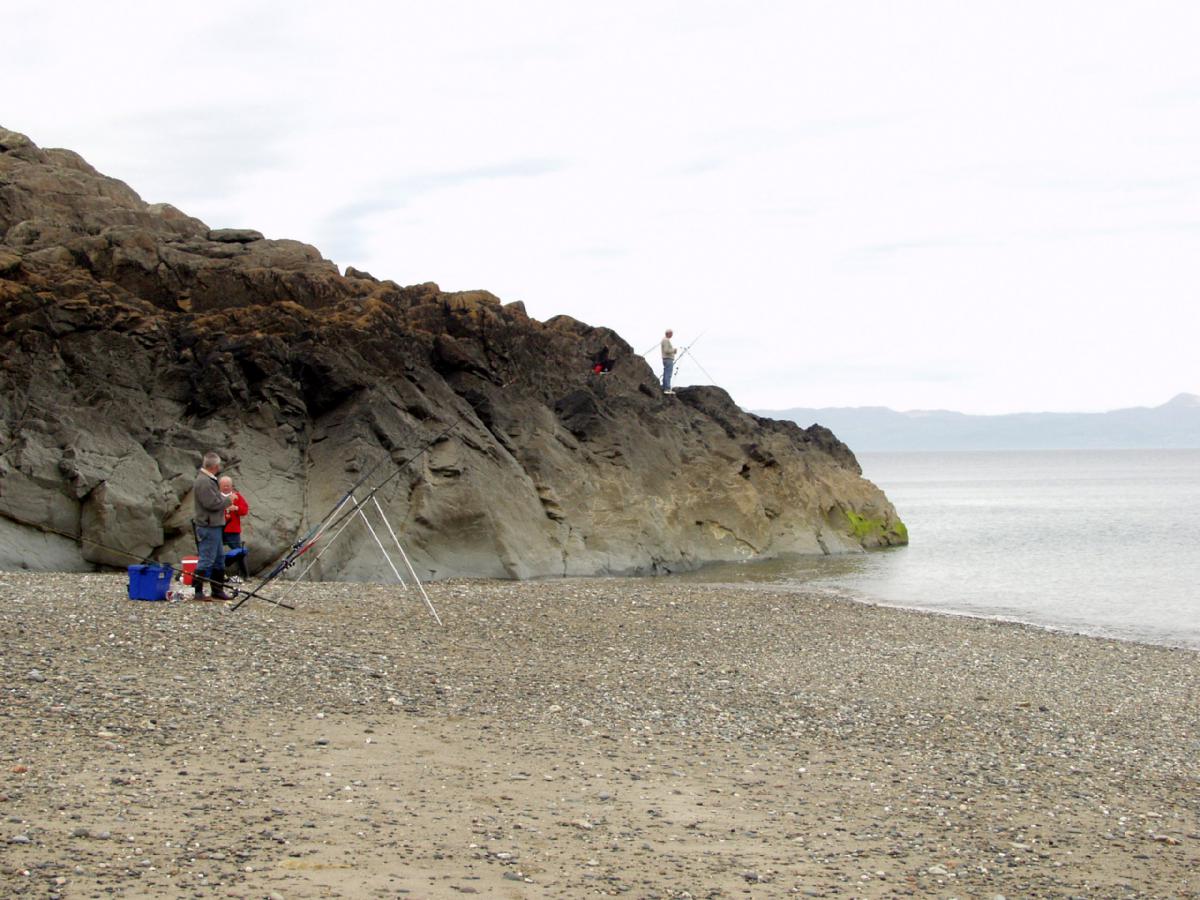
The beach stretches from Gimblet Rock at it's eastern end westwards for almost 5km or 3 miles to Traeth Crugan at it's western end. Most of the fishing is concentrated between Gimblet Rock and the Golf Course. The water is slightly deepr close to Gimblet Rock. The list of species available is pretty extensive and includes sizeable tope.
For some reason smooth hounds are noticeable by their absce in this area. It can only be a matter of time before they start to be caught as in recent years their range has steadily been increasing and they are being caught from places with no previous history of them.

Criccieth
One of my favoriteplaces to fish. You can the beach on the western side of the castle. On the eastern side of the castle you have the stone jetty, the promenade or the extensive beach stretching from the end of the prom right the way to the black rocks. The list of species just about covers all the ususal suspects with the exception of Smooth Hound and codling.
The town itself has a very good tackle shop 'Criccieth Tackle Box'. The shop majors on lure fishing but it also has a good selection of frozen baits.
The town itself has a very good tackle shop 'Criccieth Tackle Box'. The shop majors on lure fishing but it also has a good selection of frozen baits.
Porthmadog and Borth-y-Gest
At it's south eastern end lies the estuary of the rivers Glaslyn and Dwyry. The confluence of the two rivers is around 1.5km or 1 mile from the harbour in Porthmadog. The estuary offers sheltered fishing for bass, mullet, flounder and silver eels. The bass fishing improves the further down the estuary towards the open sea but this part of the estuary is a mecca for jet skiers so very early mornings or late at night is best. Can be fished over LW and HW. My fish really well about 3 or 4 hrs before HW as the flood starts to overspill onto the snads from the main channels.
Light surf or carp rods are adequate with plain leads to allow the bait to move slowly with the tide. Harbour rag and crab are prime baits!
